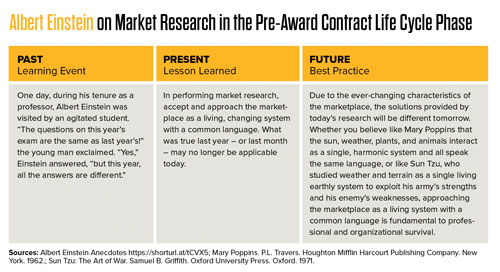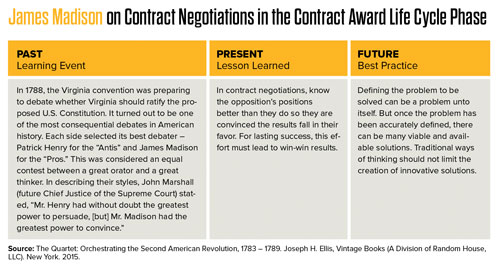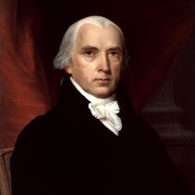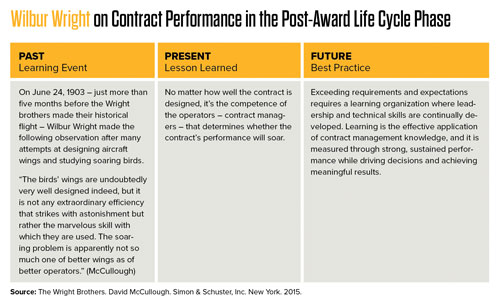Drawing on the Genius of Giants
How Einstein, Madison, and Wright contribute to the practice of contract management.
By John Wilkinson, EdD, CPCM (Retired), CFCM (Retired), Fellow
 Who knew that Albert Einstein could be a subject matter expert in market research; James Madison could offer advice for contract negotiations; and Wilbur Wright’s insights about flight could apply to contract performance? These three competencies are crucial to contract success and cover all phases of the contract life cycle—pre-award, award, and post-award.1
Who knew that Albert Einstein could be a subject matter expert in market research; James Madison could offer advice for contract negotiations; and Wilbur Wright’s insights about flight could apply to contract performance? These three competencies are crucial to contract success and cover all phases of the contract life cycle—pre-award, award, and post-award.1
Geniuses in their own professions, they provide valuable learning points that are applicable for contract managers today.
Albert Einstein on Market Research in the Pre-Award Contract Life Cycle Phase


Opportunity
Assuming that the marketplace will cooperate with your timeline and other such assumptions can lead to doom. Researching the living marketplace means due diligence in properly interpreting the language and direction of a moving target. You must understand how the needs of your organization align with the current situation and how accurate forecasting of future trends can mitigate risks and reveal opportunities.
In addition to the traditional research covering salient characteristics of goods and services, contract managers must dig deeper to understand the business environment and the common language for describing those characteristics in contract documents to increase the likelihood of successful performance.
Following are important business management topics to include in market research:
➢ Accounting is important because it is used in estimating costs.
➢ Economics is important because supply and demand will drive the level of competition.
➢ Financial analysis is important because it can determine the financial health of a seller.
➢ Information science/technology is important because information drives decisions and must be handled with confidentiality.
➢ Marketing is important because the product life cycle will influence price and availability.
➢ Operations management is important because it determines lead times and quality.2
The benefits of adopting a common language include the following:
➢ Since productivity relies on dialogue, common language is a form of process improvement.
➢ It increases the likelihood that innovative concepts are understood and successfully adopted.
➢ It connects all stakeholders’ work and improves the ability to exchange ideas.
➢ Simplifying processes for clarity can remove constraints on productivity.
James Madison on Contract Negotiations in the Contract Award Life Cycle Phase


Opportunity
Win-win negotiations require skill and knowledge of the positions of both sides.3 When both sides are genuinely concerned about each other’s well-being, participants are motivated. This mindset requires courage, consideration, and trust when dealing with others—but not at the expense of risk management.
Even those with good intentions can be tempted by the “sins of solution,” products of the headlong drive to solve problems before all else. Avoid:
1. Shortcutting. Leaping to solutions in an instinctive or intuitive way seldom leads to elegant solutions because deeper, hidden causes don’t get addressed.
2. Blind spots. These are assumptions, biases, and mindsets that cannot be seen through or around. Our brain does a lot of filling in for us because it’s a patternmaker and recognizer. But this filling in creates impediments to clear thinking.
3. Not Invented Here (NIH). NIH means refusing to consider solutions from external sources. “If we didn’t come up with it, it won’t work.”
4. Satisficing. When solutions lack inspiration, imagination, and originality it’s often because by nature we satisfice (satisfy plus suffice). We glom onto what’s easy and stop looking for the best solution.
5. Downgrading. Downgrading is a close cousin to satisficing but with a twist. We fall short of the goal, so we revise it to one that allows us to declare victory. Why? No one likes to fail.
6. Complicating. Why do we overthink, complicate, and add cost? We’re hard-wired that way. Our brains are designed to drive hoarding, storing, accumulating, and collecting behavior.
7. Stifling. We naturally do the “Yes, but” dance, in which we stifle, dismiss, and second-guess ideas. It’s ideacide, pure and simple. And it’s not just others’ ideas we stifle; we often do it to our own and kick ourselves later when someone else “steals” them.4
Wilbur Wright on Contract Performance in the Post-Award Life Cycle Phase

 Opportunity
Opportunity
Growth in workforce professional development is achieved through the compound effect of continuous learning events by applying leadership, management, and technical skills in a single, integrated process.5
To alleviate the inherent risks involved in poor contract management and to improve capability:
1. Use individual development plans.
2. Provide developmental opportunities.
1. Individual Development Plan (IDP). The IDP is the heart of career planning. It is based on both formal and informal assessments and identifies areas in which the employee should increase knowledge and skills to reach career goals. An IDP specifically addresses the education, training, development, and job assignments required to progress in a contract management career, improve business skills, and grow professionally and personally. The use of the IDP allows planning, scheduling, and budgeting of training and development for each employee.
2. Developmental Opportunities. Designed to broaden experiences and expand contract management and business skills, developmental opportunities are vital components in developing the workforce. Developmental opportunities provide skills beyond the classroom that enable employees to become well-rounded professionals, benefitting them and their organizations.
Examples of developmental opportunities include:
➢ Rotational and developmental assignments
➢ Participation in mentoring programs
➢ Teams and workgroups
➢ Membership in professional associations
Rotational and developmental assignments provide valuable experience gained by working on a variety of assignments in other organizations. Rotational and developmental assignments include cross-training and build skills in other disciplines. This fosters broader understanding of other disciplines and enhances cross-functional team relationships.
Mentorship provides coaching and feedback for career planning as well as improved job performance and personal growth. Each mentoring relationship is unique and varies according to the needs and interests of participants. Mentoring benefits are reciprocal and long lasting.
Team and workgroup participation at the interoffice, agency, or department level offers opportunities to:
➢ Collaborate with professionals of various backgrounds
➢ Gain additional contract management knowledge exposure to related fields and subject matter
➢ Share best practices
➢ Improve team building and communication skills
`Professional association membership is voluntary but strongly encouraged. Members gain opportunities for sharing information and ideas through professional journals and other periodicals, seminars, networking, and certification opportunities. Some associations offer Continuous Professional Education (CPE) earned by attending and presenting at their learning events, writing for approved publications, and mentoring.6
Summary
How will you make your historical mark on your profession, organization, and the world? Einstein, Madison, and Wright were not instant successes. Over time they achieved unbounded greatness through a deep yearning for learning and painstaking due diligence to make themselves and those around them better. We can apply their experience and insight to become the world’s best contract managers. Will you become the combined “James Wilbur Einstein” – the best contract manager on planet Earth? The opportunity is yours. CM
John Wilkinson, EdD, CPCM (Retired), CFCM (Retired), Fellow is the president of tHInc, LLC. To see more of his background and other Contract Management articles he has authored and co-authored, please visit his LinkedIn profile.
ENDNOTES
1 Contract Management Standard™, Third Edition, National Contract Management Association, 2022
https://www.ncmahq.org/Web/Web/Standards---Practices/Contract-Management-Standard-Publication.aspx?hkey=5f1fdc7a-f748-437d-a5a1-3e9af7cdb83c
2 Management, Chapter 4, “Contract Management Body of Knowledge®, Seventh Edition, National Contract Management Association, 2023.
3 Guiding Principles, Chapter 5, “Contract Management Body of Knowledge®” Seventh Edition, National Contract Management Association, 2023.
4 Reality Check: The Irreverent Guide to Outsmarting, Outmanaging, and Outmarketing Your Competition. Guy Kawasaki. Penguin Group, Inc. New York. 2008.
5 Wilkinson, John W., “What’s New in CMBOK 7.” Contract Management (January 2023).
6 Contract Management Continuing Professional Education Guide, NCMA
https://www.ncmahq.org/Web/Web/Standards---Practices/Continuing-Professional-Education-Guide.aspx?hkey=2ad0670f-4281-4354-91de-aa4b8e21bf78